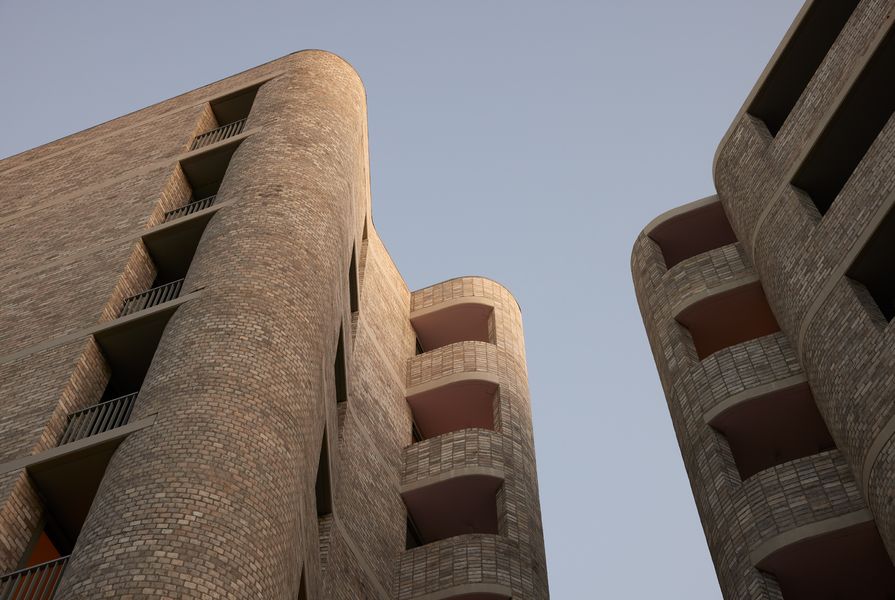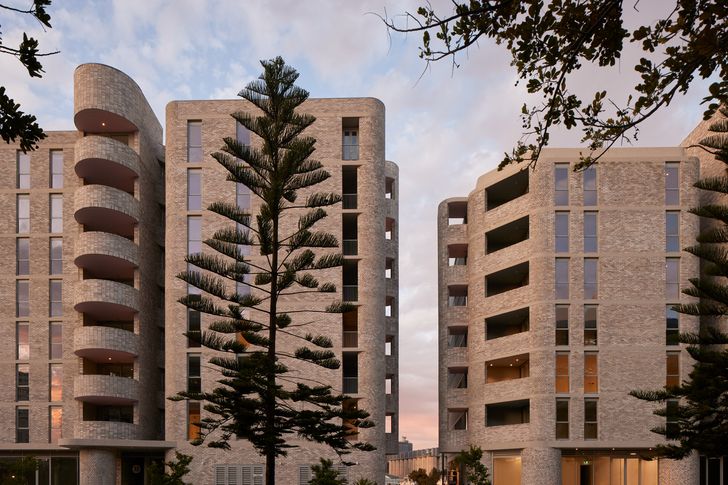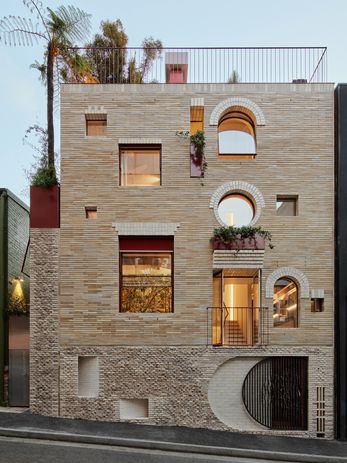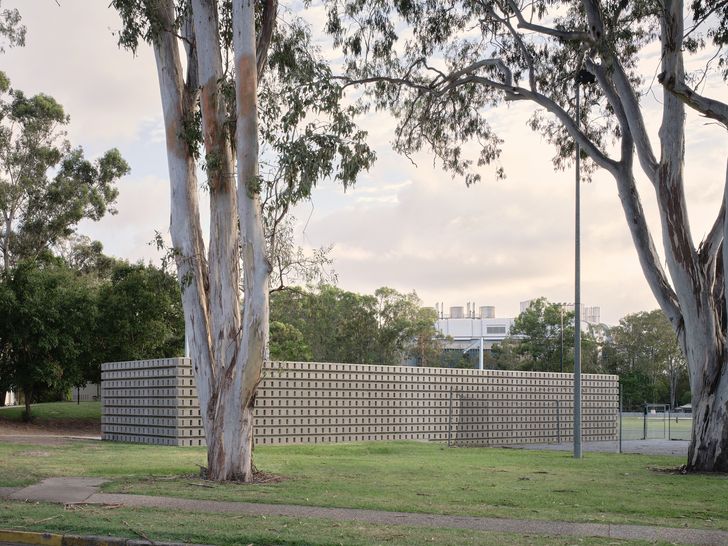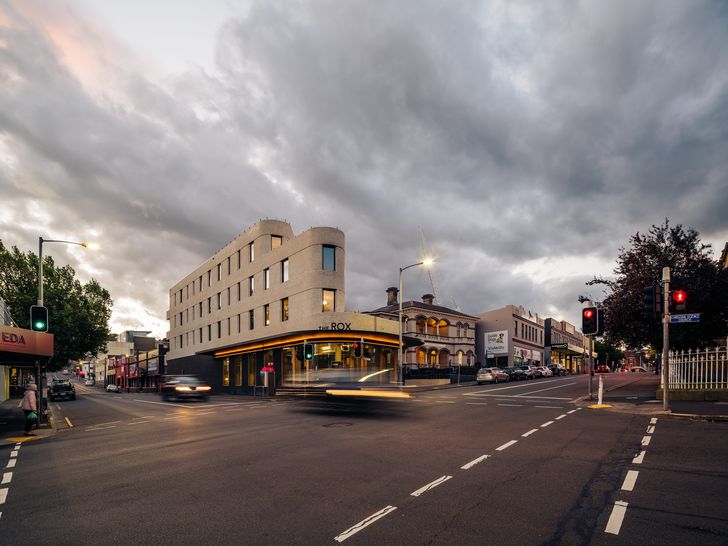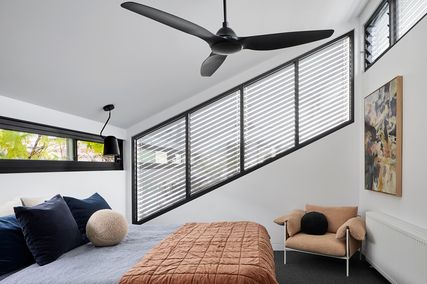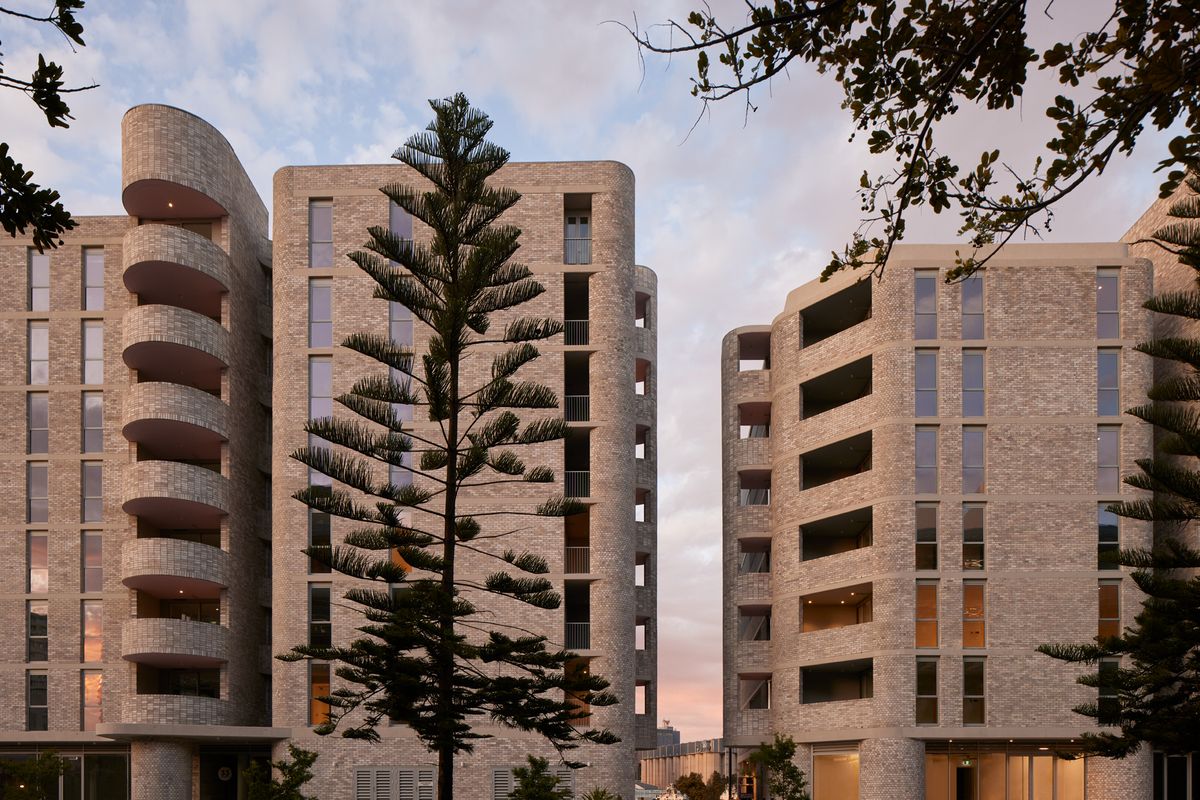The 2023 Think Brick Awards winners have been revealed, with several design practices recognized for their creative and clever use of bricks, blocks, pavers and roof tiles in projects.
The awards jury consisted of Claire Martin (associate director of Oculus), Mark Trotter (director of Fulton Trotter), Chris Major (co-founder of Welsh and Major), Andrew Benn (director of Benn and Penna), Elizabeth McIntyre (former CEO of Think Brick Australia).
Horbury Hunt Commercial Award – category winner
Huntington – SJB
Mixed-use residential development, Huntington received the Horbury Hunt Commercial Award.
Image: Tom Roe
Sited at 35 Honeysuckle Drive in Newcastle, Huntington is a mixed-use residential development with a retail offering, comprising approximately 90 apartments across three distinct architectural forms. The development sits within a revitalized housing precinct on the Hunter foreshore, which was formerly used for large-scale commercial and manufacturing operations. Industrial elements reflective of the city’s history have been interwoven into the design, showcasing a warm blend of cloudy silver and smoky cashmere brick tones.
The jury praised SJB, saying the aesthetic is reminiscent of a Louis Kahn project.
“Huntington showcases brickwork in its monolithic form, which is not an easy thing to do in architecture. The bold, singular use of brick has given the building a fabric-like quality and addressed the project’s scale and prominent location with an exceptional interplay of restraint and materiality. Its clever articulation and attention to detail is sure to encourage people to be committed to using brickwork and doing it well,” the jury remarked.
The Crossing by Chrofi Architects, De Rome Architects and Dezignteam; St Margaret’s Sports Precinct by Blight Rayner Architecture; Whitton Lane by Jackson Clements Burrows Architects and DJRD; and The Rox by Core Collective Architects all received high commendations.
Horbury Hunt Residential Award – category winner
Waterloo Street – SJB
Waterloo Street by SJB.
Image: Anson Smart
Waterloo Street playfully engages with passersby through the arrangement, texture and geometry of its recycled and broken brick facade. Internally, the residence integrates custom brick flooring and custom glazed bricks to add detail and aesthetic value. At the core of the design brief is the desire to create a home that is sustainable, which is achieved through the imaginative re-purposing of materials.
“With a footprint of just 30 square metres, Waterloo Street is like a little brick jewellery box in the neighbourhood that adds real joy and interest to the street. The creative brickwork ideas on display are both familiar and strange, yet beautifully cohesive,” the jury commented.
“This home, with its geometric openings and facade of recycled and broken bricks, playfully shows how it is possible for private buildings to make positive contributions to public spaces by eliciting a sense of delight in passersby.”
Earning high commendations wer Coleman Bajrovic Residence by Klopper and Davis Architects; Gathering House by Inarc Architects; Mary Street House by Edition Office; and Shakespeare Grove by B.E. Architecture.
Kevin Borland Masonry Award – category winner
University of Queensland Cricket Club Maintenance Shed – Lineburg Wang and Steve Hunt Architect
University of Queensland Cricket Club Maintenance Shed by Lineburg Wang and Steve Hunt Architect.
Image: David Chatfield
The University of Queensland Cricket Club Maintenance Shed is an innovative example of how stucture and ornamentation can be one in the same. The idea for the shed emerged out of construction pricing and material supply constraints during the pandemic. The project illustrates how conventional building materials can be used in an unconventional way.
The jury said the design takes the use of blocks somewhere new and exciting.
“Installing blocks as a screen is an incredibly inventive way of putting a building together. Super creative masonry has been used structurally and functionally, as well as expressively. The way the shed rises out of the landscape is fantastic. This relatively small project is quite provocative and very singular in its vision.”
Sunday by Architecture Architecture, Garden Tower House by Studio Bright, Deepwater House by AHA Studio, and Weather House by Mihaly Slocombe were highly commended in this category.
Robin Dods Roof Tile Excellence Award – category winner
Bondi Pavilion Conservation and Restoration Project – Tonkin Zulaikha Greer Architects
Bondi Pavilion Conservation and Restoration Project by Tonkin Zulaikha Greer Architects.
Image: Brett Boardman
Bondi Pavilion is a multi-purpose community hub and world-famous heritage landmark that has been conserved and upgraded. One of the standout features of the transformation is the reconstruction of the original multi-coloured cordova-tiled roof, in replacement of a 1960s grey concrete incarnation.
The jury said the multi-coloured roof tiles are the hero of the historic restoration of the iconic Bondi Pavilion.
“The new roofing materials have been expertly applied to re-interpret the building’s heritage and celebrate Australia’s beach culture. Painstakingly reconstructing the Pavilion’s original, ocean-hued roof elevates it to something textural and reinvigorates the whole building. Its tiles will be there in a hundred years from now, other products won’t be. After an unsympathetic renovation in the 1960s, people no longer noticed the roof, now it’s ‘the thing’.”
Viridi by Plus Architecture and TLG Roofing, St Patricks College Ballarat Residence by Ballarat Bricks and Roofing, Avondale by Aeta Studio, and Clay Hip and Valley by APT Roofing, were highly commended by the jury.
Bruce Mackenzie Landscape Award – category winner
Allianz Stadium – Aspect Studios and Cox Architecture
Allianz Stadium by Aspect Studios and Cox Architecture.
Image: Florian Groehn
The Allianz Stadium public domain makes use of a paving mix to mark the key entry sites and active gathering spaces. Brick walls highlight and provide clear direction to the main entrances, with brick bonding thoughtfully incorporating textures and patterns.
“It is hard to make a large area feel intimate and activated, yet the brick patterning brings the
scale of this project down to a human level and helps to animate the stadium. The patterns
in the bricks and pavers create an “urban carpet” that’s visually appealing from all directions.
This urban carpet serves to connect the neighbourhood and facilitate pleasant journeys.
There’s a real strength in the design idea and execution of the work that showcases the value
of making long-lasting investments in public spaces,” the jury said.
Highly commended projects included Wren House by Wolveridge Architects and Bethany Williamson Architecture; Melbourne Connect by Aspect Studios, Woods Bagot and Hayball; Burwood Brickworks Playspace by MDG Landscapes; and Long Reef Surf Club Public Domain by Tyrell Studio.
New Entrant Award – category winner
The Rox – Core Collective Architects
The Rox by Core Collective Architects.
Image: Adam Gibson
The residential development comprises 13 apartments and a ground floor commercial space. The project involved a careful restoration of the historic Scotch College at the rear of Roxburgh
House to accommodate two new apartments. The design team drew on nearby buildings to inform the architectural expression.
The jury applauded the design team for making a sophisticated statement about brick.
“It’s simple, elegant and fits snugly in its urban context. Brickwork has been used to great effect in this cleverly conceived design solution that frames the street. The scale, colour and masonry materials are respectful of the surrounds and humanising. The sense of invitation engendered in the construction is reinforced by the carefully considered brick selections.”
Residence 264 by Enzo Carosco Architecture; Thyne House by X Squared Architects and Robert Carroll and Associates; Millard Place Terraces Glebe by WMK Architecture; and St Margarets Sports Precinct by Blight Rayner Architecture each earned a high commendation.

